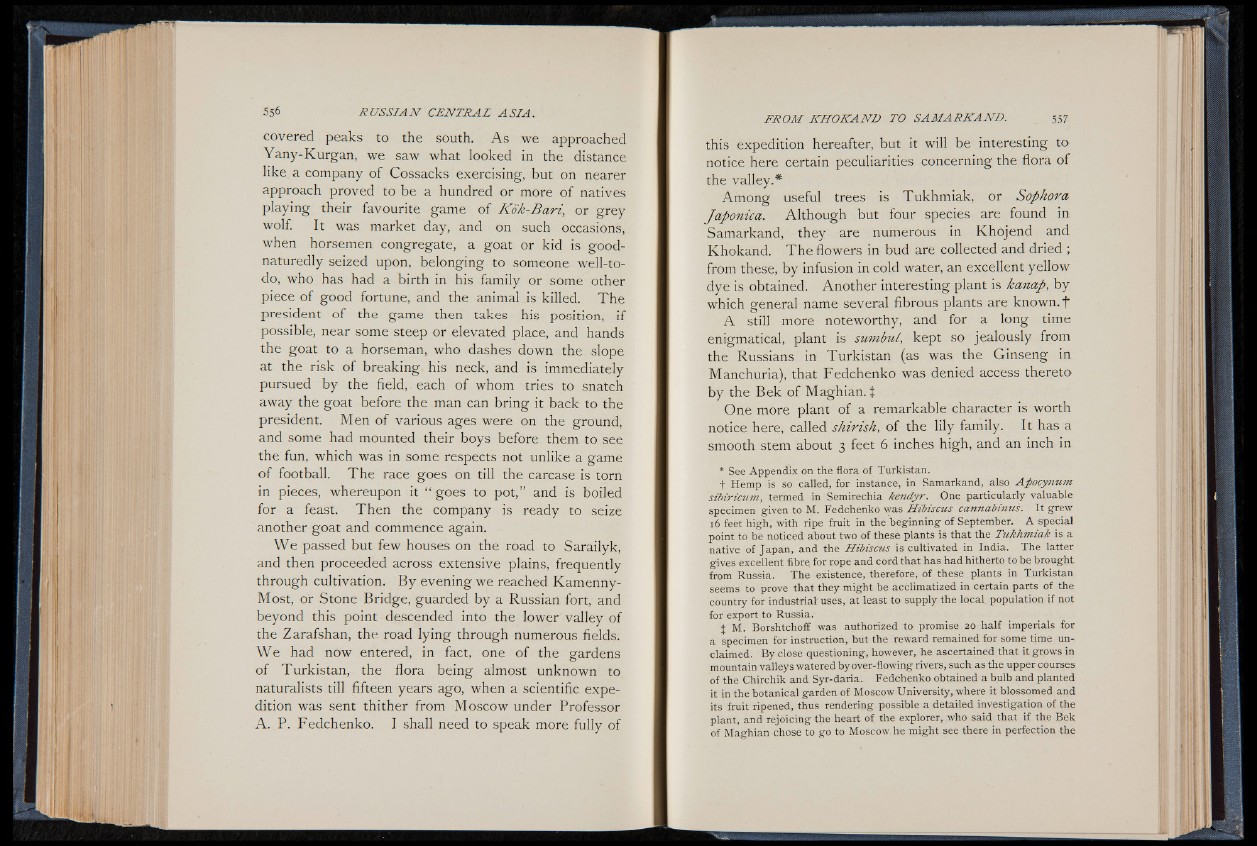
covered peaks to the south. A s we approached
Yany-Kurgan, we saw what looked in the distance
like a company of Cossacks exercising, but on nearer
approach proved to be a hundred or more of natives
playing their favourite game of K ok-Bari, or grey
wolf. It was market day, and on such occasions,
when horsemen congregate, a goat or kid is good-
naturedly seized upon, belonging to someone well-to-
do, who has had a birth in his family or some other
piece of good fortune, and the animal is killed. The
president of the game then takes his position, if
possible, near some steep or elevated place, and hands
the goat to a horseman, who dashes down the slope
at the risk of breaking his neck, and is immediately
pursued by the field, each of whom tries to snatch
away the goat before the man can bring it back to the
president. Men of various ages were on the ground,
and some had mounted their boys before them to see
the fun, which was in some respects not unlike a game
o f football. The race goes on till the carcase is torn
in pieces, whereupon it “ goes to pot,” and is boiled
for a feast. Then the company is ready to seize
another goat and commence again.
We passed but few houses on the road to Sarailyk,
and then proceeded across extensive plains, frequently
through cultivation. By evening we reached Kamenny-
Most, or Stone Bridge, guarded by a Russian fort, and
beyond this point descended into the lower valley of
the Zarafshan, the road lying through numerous fields.
W e had now entered, in fact, one of the gardens
of Turkistan, the flora being almost unknown to
naturalists till fifteen years ago, when a scientific expedition
was sent thither from Moscow under Professor
A. P. Fedchenko. I shall need to speak more fully of
this expedition hereafter, but it will be interesting to
notice here certain peculiarities concerning the flora of
the valley.*
Among useful trees is Tukhmiak, or Sophora
Japonica. Although but four species are found in
Samarkand, they are numerous in Khojend and
Khokand. The flowers in bud are collected and dried j
from these, by infusion in cold water, an excellent yellow
dye is obtained. Another interesting plant is kanap, by
which general name several fibrous plants are known, j"
A still more noteworthy, and for a long time
enigmatical, plant is sumbul, kept so jealously from
the Russians in Turkistan (as was the Ginseng in
Manchuria), that Fedchenko was denied access thereto
by the Bek of Maghian. %
One more plant of a remarkable character is worth
notice here, called shirish, of the lily family. It has a
smooth stem about 3 feet 6 inches high, and an inch in
* See Appendix on the flora of Turkistan.
t Hemp is so called, for instance, in Samarkand, also Ajiocynum
sibiricum, termed in Semirechia kendyr. One particularly valuable
specimen given to M. Fedchenko was Hibiscus cannabmus. It grew
16 feet high, with ripe fruit in the beginning of September. A special
point to be noticed about two of these plants is that the Tukhmiak is a
native of Japan, and the Hibiscus is cultivated in India. The latter
gives excellent fibre for rope and cord that has had hitherto to be brought
from Russia. The existence, therefore, of these plants in Turkistan
seems to prove that they might be acclimatized in certain parts of the
country for industrial uses, at least to supply the local population if not
for export to Russia.
t M. Borshtchoff was authorized to promise 20 half imperials for
a specimen for instruction, but the reward remained for some time unclaimed.
By close questioning, however, he ascertained that it grows in
mountain valleys watered by over-flowing rivers, such as the upper courses
of the Chirchik and Syr-daria. Fedchenko obtained a bulb and planted
it in the botanical garden of Moscow University, where it blossomed and
its fruit ripened, thus rendering possible a detailed investigation of the
plant, and rejoicing the heart of the explorer, who said that if the Bek
of Maghian chose to go to Moscow.he might see there in perfection the